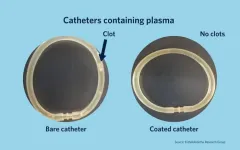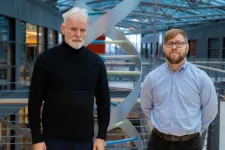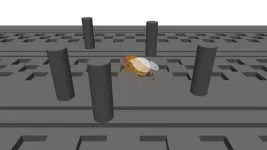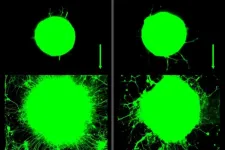(Press-News.org) Next-generation metagenomic sequencing test developed at UCSF proves its effectiveness in quickly diagnosing almost any kind of pathogen.
A genomic test developed at UC San Francisco to rapidly detect almost any kind of pathogen – virus, bacteria, fungus or parasite – has proved successful after a decade of use.
The test has the potential to vastly improve care for neurological infections that cause diseases like meningitis and encephalitis, as well as speed up the detection of new viral pandemic threats. It uses a powerful genomic sequencing technique, called metagenomic next-generation sequencing (mNGS).
Rather than looking for one type of pathogen at a time, mNGS analyzes all the nucleic acids, RNA and DNA, that are present in a sample.
“Our technology is deceptively simple,” said Charles Chiu, MD, PhD, professor of laboratory medicine and infectious diseases at UCSF and senior author of the study. “By replacing multiple tests with a single test, we can take the lengthy guesswork out of diagnosing and treating infections.”
The researchers originally developed a clinical mNGS test to analyze cerebrospinal fluid (CSF), the pristine liquid that bathes the brain and spinal cord.
The test has now been performed on thousands of patients with unexplained neurological symptoms, both at UCSF and other hospitals across the country.
In a paper that appears Nov. 12 in Nature Medicine, the team demonstrated that the mNGS test correctly identified 86% of neurological infections.
In a companion study published the same day in Nature Communications, the team also used mNGS to identify pathogens in respiratory fluid that can cause pneumonia, and automated it to get results faster.
They expect that the automated test will be able to detect novel viral pathogens that could cause respiratory pandemics like COVID-19.
A breakthrough in diagnosing rare, infectious neurological disease
Neurological diseases can be very hard to diagnose, especially when the cause is a rare or previously unknown pathogen. In many cases, each day without a diagnosis means a continual worsening of a patient’s condition.
In the early 2010s, Chiu, along with UCSF colleagues Joe DeRisi, PhD, and Michael Wilson, MD, developed a novel metagenomic sequencing method to test CSF for potential pathogens causing neurologic infections.
The test works by sequencing all the genetic material in CSF, then running a computational analysis pipeline to separate human sequences from those that originate from bacteria, viruses, fungi or parasites.
In 2014, the team used the technology to help doctors in Wisconsin treat a young boy who was critically ill in the intensive care unit with an undiagnosed infection.
A long series of tests had failed to find out what was wrong with him, but UCSF’s test took just 48 hours to reveal that the boy had leptospirosis, which is treatable with penicillin. His doctors gave it to him, and he fully recovered.
The mNGS test soon became routine at UCSF, with hospitals and clinics nationwide sending samples to be processed by the UCSF Clinical Microbiology Laboratory, of which Chiu is the director.
Between 2016 and 2023, the UCSF team analyzed nearly 5,000 CSF samples with the test, 14.4% of which turned out to have an infection. In those samples, the test accurately identified the pathogen 86% of the time.
“Our mNGS test performs better than any other category of test for neurologic infections,” Chiu said, “The results support its use as a critical part of the diagnostic armamentarium for physicians who are working up patients with infectious diseases.”
To increase access to this technology, Chiu, DeRisi, Wilson and others helped found Delve Bio, which is now the exclusive provider of the mNGS CSF test developed at UCSF.
“These findings support including mNGS as a core tool in the clinical workup for CNS infections,” said Steve Miller, MD, PhD, chief medical officer of Delve Bio. “mNGS offers the single most unbiased, complete and definitive tool for pathogen detection. Thanks to its ability to quickly diagnose an infection, mNGS helps guide management decisions and treatment for patients with meningitis and encephalitis, potentially reducing healthcare costs down the line.”
Preparing for the next pandemic
If it is going to serve as an early-warning system for pandemics, the mNGS test must be fast. Chiu and his colleagues have adapted it to work with respiratory fluid and figured out how to automate it.
Whereas the CSF test entails more than 100 separate steps and can take 2 to 7 days to process, the respiratory test requires just 30 minutes of hands-on time before robots and algorithms can take over.
“Our goal was to have the entire process completed within 12 to 24 hours, giving a same-day or next-day result,” Chiu said.
In the Nature Communications study, the researchers demonstrated that the test could detect respiratory viruses with pandemic potential, including SARS-CoV-2, influenza A and B, and RSV in less than a day, even when there were only small amounts of virus present in a sample.
They also modeled the technology’s ability to detect divergent viruses – or newly-evolved strains – and found that it could hypothetically detect all of them, should they emerge in the future.
Both the CSF and respiratory versions of the mNGS test have received breakthrough device designation from the U.S. Food and Drug Administration (FDA).
Authors: For the Nature Medicine paper, other UCSF authors are Patrick Benoit, MD, Noah Brazer, Mikael de Lorenzi-Tognon, MD, PhD, Emily Kelly, MD, MS, Venice Servellita, MS, Miriam Oseguera, Jenny Nguyen, MD, MA, Jack Tang, MHS, Charles Omura, Jessica Streithorst, PhD, Melissa Hillberg, Danielle Ingebrigtsen, MHS, Kelsey Zorn, MHS, and Michael R. Wilson, MD. For all authors, see the paper.
For the Nature Communications paper, other UCSF authors are Jessica Karielle Tan, PhD, Venice Servellita, MS, Doug Stryke, Emily Kelly, MD, MS, Jessica Streithorst, PhD, Nanami Sumimoto, Abiodun Foresythe, Hee Jae Huh, Jenny Nguyen MD, MA, Miriam Oseguera, Noah Brazer, Jack Tang, MHS, Danielle Ingebrigtsen, MHS, Becky Fung, Helen Reyes, Melissa Hillberg, Peter M. Mourani, Charles R. Langelier, MD, PhD, Mikael de Lorenzi-Tognon, MD, PhD, and Patrick Benoit, MD. For all authors, see the paper.
Funding: The Nature Medicine paper was supported in part by a BARDA EZ-BAA award 75A50122C00022, US CDC grants 75D30122C15360 and 75D30121C12641 and the Chan Zuckerberg Biohub San Francisco.
The Nature Communications paper was supported in part by in part by a BARDA EZ-BAA 494 award 75A50122C00022, US CDC grants 75D30122C15360 and 75D30121C12641, Abbott Laboratories and the Chan Zuckerberg Biohub San Francisco.
Disclosures: Chiu is a founder of Delve Bio and serves on its scientific advisory board, as well as those of Flightpath Biosciences, Biomeme, Mammoth Biosciences, BiomeSense and Poppy Health. He is also an inventor on US patent 509 11380421, “Pathogen detection using next generation sequencing.” Wilson is a co-founder and serves on the scientific advisory board and board of directors for Delve Bio.
About UCSF: The University of California, San Francisco (UCSF) is exclusively focused on the health sciences and is dedicated to promoting health worldwide through advanced biomedical research, graduate-level education in the life sciences and health professions, and excellence in patient care. UCSF Health, which serves as UCSF's primary academic medical center, includes top-ranked specialty hospitals and other clinical programs, and has affiliations throughout the Bay Area. UCSF School of Medicine also has a regional campus in Fresno. Learn more at ucsf.edu, or see our Fact Sheet.
###
Follow UCSF
ucsf.edu | Facebook.com/ucsf | YouTube.com/ucsf
END
One genomic test can diagnose nearly any infection
2024-11-12
ELSE PRESS RELEASES FROM THIS DATE:
Blood vessel-like coating could make medical devices safer for patients
2024-11-12
University of B.C. researchers have developed a groundbreaking coating that could make medical devices safer for millions of patients, reducing the risks associated with blood clots and dangerous bleeding.
The new material, designed to mimic the natural behavior of blood vessels, could allow for safer use of blood-contacting devices like catheters, stents, blood-oxygenation machines and dialysis machines—especially in cases where blood clots are a significant concern.
“This discovery could be a transformative step in the development of safer medical devices,” said Dr. Jayachandran Kizhakkedathu, ...
Sleep is no light matter for bees
2024-11-12
In an emerging red flag for the digital era, sleep experts have warned us to avoid screen time in bed, sounding the alarm that light emitted from phones and other electronic devices can disrupt our sleep patterns. That’s one way that science is waking up to the broad range of health and disease implications related to circadian biology and our daily sleep-wake cycles.
Now, researchers at the University of California San Diego have found that light disruption is not only a health concern for humans. A new study led by PhD candidate Ashley Kim and Professor James Nieh in the School of Biological Sciences has found that artificial light disrupts the circadian rhythms of ...
New study explores the role of BMI in disease risk
2024-11-12
New study from deCODE genetics/Amgen highlights the importance of BMI in pathogenesis of disease, suggesting that reducing BMI alone could lower the risk of several diseases.
Scientists at deCODE genetics, subsidiary of Amgen, published a study today in Nature Communications that sheds light on how Body Mass Index (BMI) influences the risk of various diseases that are comorbid with obesity. The study, which used genetic data from Iceland and the UK Biobank, looked at whether disease risk associated with BMI-related sequence variants are explained completely or partially by their effect on BMI.
The results showed that for some conditions, such as fatty liver disease, glucose intolerance, ...
Guardian, kids, or companions? What do dogs mean to us today
2024-11-12
What role do dogs play in today’s world? For many, they are more than just pets. New findings from the Department of Ethology at Eötvös Loránd University show that whether seen as friends, family members, children or guardians, these roles affect the way dogs are cared for, suggesting shifting dynamics in human-animal bonds shaped by societal trends and individual owner profiles.
In Western cultures, more and more people see their dogs as their best friends, family members or even their furry children. In fact, ...
NeuroMechFly v2: Simulating how fruit flies see, smell, and navigate
2024-11-12
All animals, large or small, have to move at an incredible precision to interact with the world. Understanding how the brain controls movement is a fundamental question in neuroscience. For larger animals, this is challenging because of the complexity of their brains and nervous systems. But the fruit fly, Drosophila melanogaster, has a smaller and therefore more easily mappable brain, allowing scientists to gain detailed insights into how its nervous system drives behavior.
To understand how the nervous system controls actions, researchers at the group of Pavan Ramdya at EPFL created a simulated reality where a virtual fly can operate ...
“Drowning” mangrove forests in Maldives signal global coastal threat
2024-11-12
Researchers have found evidence that mangrove forests – which protect tropical and subtropical coastlines – are drowning in the Maldives.
Their findings, published today (Tuesday 12 December) in Scientific Reports, indicate that rising sea level and a climate phenomenon known as the Indian Ocean Dipole have led to some Maldivian islands losing over half of their mangrove cover since 2020.
The research team, led by Northumbria University, warn that the findings have implications not only for the Maldives, but also for other island nations and coastal ecosystems around the world.
In 2020, more than a quarter of the Maldivian islands containing mangrove forests saw their trees experiencing ...
When muscles work out, they help neurons to grow, a new study shows
2024-11-12
There’s no doubt that exercise does a body good. Regular activity not only strengthens muscles but can bolster our bones, blood vessels, and immune system.
Now, MIT engineers have found that exercise can also have benefits at the level of individual neurons. They observed that when muscles contract during exercise, they release a soup of biochemical signals called myokines. In the presence of these muscle-generated signals, neurons grew four times farther compared to neurons that were not exposed to myokines. These cellular-level experiments suggest that exercise can have a significant biochemical effect on nerve growth.
Surprisingly, the researchers also ...
Smokers who switch to vaping see improved respiratory health
2024-11-12
A new paper in Nicotine and Tobacco Research, published by Oxford University Press, finds that people who switch from smoking cigarettes to vaping see improved respiratory health, but people who begin consuming electronic cigarettes while continuing to smoke regular cigarettes do not report improved respiratory symptoms.
Adults increasingly use electronic cigarettes to try to quit smoking because of the perceived reduced risk. But while vaping reduces exposure to toxic chemicals, it has been unclear whether switching from cigarettes to e-cigarettes results in a reduction of the respiratory problems—like wheezing and coughing—common in regular cigarette ...
Air pollution emerges as critical environmental risk factor for autism, emerging topic review finds
2024-11-12
Boston, Massachusetts, 12 November 2024 – Environmental exposure to air pollutants during critical developmental periods may significantly impact autism risk, according to a groundbreaking Emerging Topic review published 12 November 2024, in Brain Medicine. The study reveals how common air pollutants, including fine particulate matter and nitrogen oxides, can trigger complex biological cascades affecting brain development.
"Different kinds of neurological disorders, including autism spectrum disorder, can be associated ...
Autism and nitric oxide: Professor Haitham Amal unveils brain disorder breakthrough
2024-11-12
Boston, Massachusetts, 12 November 2024 – The complex interplay between nitric oxide and brain disorders takes center stage in the latest Genomic Press Interview, published November 12, 2024, in Brain Medicine. Professor Haitham Amal, head of the Laboratory of Neuromics, Cell Signaling, and Translational Medicine at the Hebrew University of Jerusalem, shares insights into his groundbreaking research and personal motivation.
“Meeting families and children with autism in Boston during my time at MIT inspired me to focus on a single goal: to help develop biological diagnostics ...








